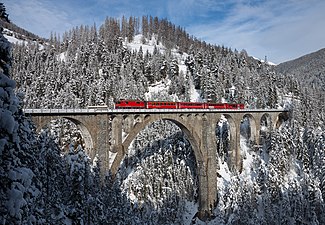Wiesen Viaduct Wiesener Viadukt | |
|---|---|
 A RhB Ge 4/4 II with a push–pull train crossing the viaduct | |
| Coordinates | 46°41′40″N 09°42′46″E / 46.69444°N 9.71278°E |
| Carries | Rhaetian Railway (RhB) |
| Crosses | Landwasser |
| Locale | Wiesen, canton of Grisons, Switzerland |
| Official name | Wiesener Viadukt |
| Owner | Rhaetian Railway (RhB) |
| Maintained by | Rhaetian Railway (RhB) |
| Characteristics | |
| Design | Arch bridge, Viaduct |
| Material | Concrete blocks with dimension stone coverage |
| Total length | 210 m (690 ft) |
| Width | 3.7 m (12 ft) |
| Height | 88.9 m (292 ft) |
| Longest span | 55 m (180 ft) |
| No. of spans | 7 |
| Piers in water | 0 |
| History | |
| Architect | G. Marasi (Westermann & Cie, Zürich), P. Salaz and Heinz Studer (RhB) |
| Designer | Friedrich Hennings |
| Constructed by | Westermann & Cie, Zürich |
| Construction start | October 1906 |
| Construction cost | CHF 324,000 (1909) |
| Opened | 1 July 1909 |
| Inaugurated | 1 July 1909 |
| Statistics | |
| Daily traffic | 29 passenger trains |
| Location | |
 | |
The Wiesen Viaduct (or Wiesener Viaduct; German: Wiesener Viadukt) is a single-track railway viaduct, made from concrete blocks with dimension stone coverage. It spans the Landwasser southwest of the hamlet of Wiesen, in the canton of Grisons, Switzerland.
Designed by the then chief engineer of the Rhaetian Railway, Henning Friedrich, it was built between 1906 and 1909 by the contractor G. Marasi (Westermann & Cie, Zürich) under the supervision of P. Salaz and Hans Studer (RhB). The Rhaetian Railway still owns and uses it today for regular service. An important element of the Davos–Filisur railway, the viaduct is 88.9 metres (292 ft) high and 210 metres (690 ft) long; it has a main span of 55 metres (180 ft).